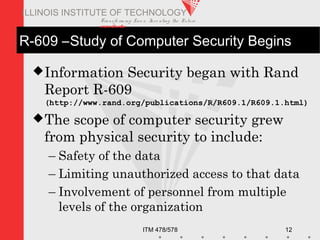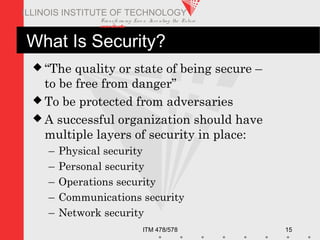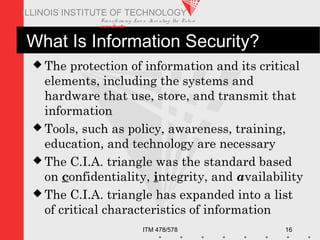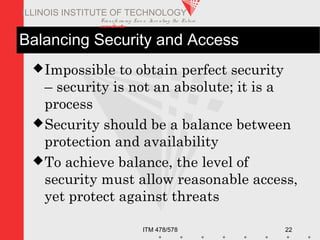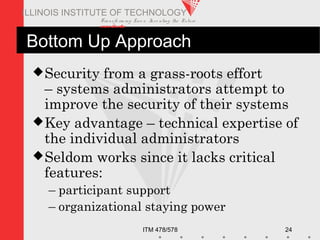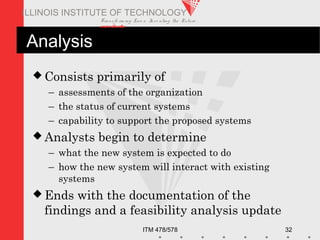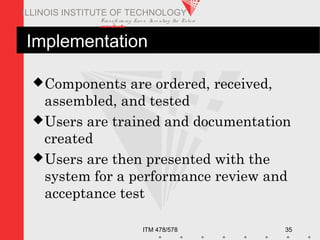Introduction to information security
- 1. TransformingLives. InventingtheFuture. www.iit.edu I ELLINOIS T UINS TI T OF TECHNOLOGY ITM 478/578 1 Introduction to Information Security Ray Trygstad ITM 478 / IT 478 / ITM 578 Spring 2005 Information Technology & Management Programs CenterforProfessional Development Slides based on Whitman, M. and Mattord, H., Principles of InformationSecurity; Thomson Course Technology 2003
- 2. Transfo rm ing Live s. Inve nting the Future . www.iit.edu ITM 478/578 2 ILLINOIS INSTITUTE OF TECHNOLOGY Introduction Today we will examine: –Course syllabus & policies –History of information security –Key terms & concepts of information security –The security systems development life cycle –The role of IS security professionals
- 3. Transfo rm ing Live s. Inve nting the Future . www.iit.edu ITM 478/578 3 ILLINOIS INSTITUTE OF TECHNOLOGY Objectives Upon completion of this lesson students should be able to: –Describe what information security is and how it came to mean what it does today –Discuss the history of computer security and how it evolved into information security
- 4. Transfo rm ing Live s. Inve nting the Future . www.iit.edu ITM 478/578 4 ILLINOIS INSTITUTE OF TECHNOLOGY Objectives –Identify and define key terms and critical concepts of information security –Outline the phases of the security systems development life cycle –Describe involved in information security in an organizational structure
- 5. Transfo rm ing Live s. Inve nting the Future . www.iit.edu ITM 478/578 5 ILLINOIS INSTITUTE OF TECHNOLOGY Syllabus & Policies Syllabus – http://www.itm.iit.edu/578/ Lectures & lecture notes Readings Assignments – Group projects Exams & Quizzes Plagiarism Other Policies
- 6. Transfo rm ing Live s. Inve nting the Future . www.iit.edu ITM 478/578 6 ILLINOIS INSTITUTE OF TECHNOLOGY What Is Information Security? Information security in today’s enterprise is a “well-informed sense of assurance that the information risks and controls are in balance.” –Jim Anderson, Inovant (2002)
- 7. Transfo rm ing Live s. Inve nting the Future . www.iit.edu ITM 478/578 7 ILLINOIS INSTITUTE OF TECHNOLOGY History Of Information Security Computer security began immediately after the first mainframes were developed Groups developing code-breaking computations during World War II created the first modern computers Physical controls were needed to limit access to authorized personnel to sensitive military locations Only rudimentary controls were available to defend against physical theft, espionage, and sabotage
- 8. Transfo rm ing Live s. Inve nting the Future . www.iit.edu ITM 478/578 8 ILLINOIS INSTITUTE OF TECHNOLOGY The Enigma
- 9. Transfo rm ing Live s. Inve nting the Future . www.iit.edu ITM 478/578 9 ILLINOIS INSTITUTE OF TECHNOLOGY The 1960s Department of Defense’s Advanced Research Project Agency (ARPA) began examining feasibility of redundant networked communications Dr. Lawrence Roberts developed the project from its inception
- 10. Transfo rm ing Live s. Inve nting the Future . www.iit.edu ITM 478/578 10 ILLINOIS INSTITUTE OF TECHNOLOGY The ARPANET
- 11. Transfo rm ing Live s. Inve nting the Future . www.iit.edu ITM 478/578 11 ILLINOIS INSTITUTE OF TECHNOLOGY The 1970s and 80s ARPANET grew in popularity as did its potential for misuse Fundamental problems with ARPANET security were identified – No safety procedures for dial-up connections to the ARPANET – User identification and authorization to the system were non-existent In the late 1970s the microprocessor expanded computing capabilities and security threats
- 12. Transfo rm ing Live s. Inve nting the Future . www.iit.edu ITM 478/578 12 ILLINOIS INSTITUTE OF TECHNOLOGY R-609 –Study of Computer Security Begins Information Security began with Rand Report R-609 (http://www.rand.org/publications/R/R609.1/R609.1.html) The scope of computer security grew from physical security to include: – Safety of the data – Limiting unauthorized access to that data – Involvement of personnel from multiple levels of the organization
- 13. Transfo rm ing Live s. Inve nting the Future . www.iit.edu ITM 478/578 13 ILLINOIS INSTITUTE OF TECHNOLOGY The 1990s As networks of computers became more common, so did the need to interconnect the networks Result was the Internet, first manifestation of a global network of networks In early Internet deployments, security was a low priority
- 14. Transfo rm ing Live s. Inve nting the Future . www.iit.edu ITM 478/578 14 ILLINOIS INSTITUTE OF TECHNOLOGY The Present The Internet has brought millions of computer networks into communication with each other – many of them unsecured Ability to secure each now influenced by the security on every computer to which it is connected
- 15. Transfo rm ing Live s. Inve nting the Future . www.iit.edu ITM 478/578 15 ILLINOIS INSTITUTE OF TECHNOLOGY What Is Security? “The quality or state of being secure – to be free from danger” To be protected from adversaries A successful organization should have multiple layers of security in place: – Physical security – Personal security – Operations security – Communications security – Network security
- 16. Transfo rm ing Live s. Inve nting the Future . www.iit.edu ITM 478/578 16 ILLINOIS INSTITUTE OF TECHNOLOGY What Is Information Security? The protection of information and its critical elements, including the systems and hardware that use, store, and transmit that information Tools, such as policy, awareness, training, education, and technology are necessary The C.I.A. triangle was the standard based on confidentiality, integrity, and availability The C.I.A. triangle has expanded into a list of critical characteristics of information
- 17. Transfo rm ing Live s. Inve nting the Future . www.iit.edu ITM 478/578 17 ILLINOIS INSTITUTE OF TECHNOLOGY Critical Characteristics of Information The value of information comes from the characteristics it possesses. – Availability – Accuracy – Authenticity – Confidentiality – Integrity – Utility – Possession
- 18. Transfo rm ing Live s. Inve nting the Future . www.iit.edu ITM 478/578 18 ILLINOIS INSTITUTE OF TECHNOLOGY NSTISSC Security Model Policy Education Technology Storage Processing Transmission Storage Processing Transmission Policy Education Technology Confidentiality Integrity Availability Confidentiality Integrity Availability FIGURE 1-3 NSTISSC Security Model
- 19. Transfo rm ing Live s. Inve nting the Future . www.iit.edu ITM 478/578 19 ILLINOIS INSTITUTE OF TECHNOLOGY Components of an Information System To fully understand the importance of information security, you need to know the elements of an information system An Information System (IS) is much more than computer hardware – The entire set of software, hardware, data, people, and procedures necessary to use information as a resource in the organization
- 20. Transfo rm ing Live s. Inve nting the Future . www.iit.edu ITM 478/578 20 ILLINOIS INSTITUTE OF TECHNOLOGY Securing the Components A computer can be either or both the subject of an attack and/or the object of an attack When a computer is – the subject of an attack, it is used as an active tool to conduct the attack – the object of an attack, it is the entity being attacked
- 21. Transfo rm ing Live s. Inve nting the Future . www.iit.edu ITM 478/578 21 ILLINOIS INSTITUTE OF TECHNOLOGY Subject and Object of Attack
- 22. Transfo rm ing Live s. Inve nting the Future . www.iit.edu ITM 478/578 22 ILLINOIS INSTITUTE OF TECHNOLOGY Balancing Security and Access Impossible to obtain perfect security – security is not an absolute; it is a process Security should be a balance between protection and availability To achieve balance, the level of security must allow reasonable access, yet protect against threats
- 23. Transfo rm ing Live s. Inve nting the Future . www.iit.edu ITM 478/578 23 ILLINOIS INSTITUTE OF TECHNOLOGY Balancing Security and Access
- 24. Transfo rm ing Live s. Inve nting the Future . www.iit.edu ITM 478/578 24 ILLINOIS INSTITUTE OF TECHNOLOGY Bottom Up Approach Security from a grass-roots effort – systems administrators attempt to improve the security of their systems Key advantage – technical expertise of the individual administrators Seldom works since it lacks critical features: – participant support – organizational staying power
- 25. Transfo rm ing Live s. Inve nting the Future . www.iit.edu ITM 478/578 25 ILLINOIS INSTITUTE OF TECHNOLOGY Approaches to Security Implementation CEO CFO CIO COO CISO VP-NetworksVP-Systems security manager network manager systems manager security admin network admin systems admin security tech network tech systems tech FIGURE 1-7 Approaches to Security Implementation Top-down approach Bottom-up approach
- 26. Transfo rm ing Live s. Inve nting the Future . www.iit.edu ITM 478/578 26 ILLINOIS INSTITUTE OF TECHNOLOGY Top-down Approach Initiated by upper management: – issue policy, procedures, and processes – dictate the goals and expected outcomes of the project – determine who is accountable for each required action Pluses: – strong upper management support – dedicated champion – dedicated funding – clear planning – chance to influence organizational culture
- 27. Transfo rm ing Live s. Inve nting the Future . www.iit.edu ITM 478/578 27 ILLINOIS INSTITUTE OF TECHNOLOGY Top-down Approach May also involve a formal development strategy referred to as a systems development life cycle – Most successful top-down approach
- 28. Transfo rm ing Live s. Inve nting the Future . www.iit.edu ITM 478/578 28 ILLINOIS INSTITUTE OF TECHNOLOGY The Systems Development Life Cycle Information security must be managed in a manner similar to any other major system implemented in the organization Using a methodology – ensures a rigorous process – avoids missing steps Goal is to create a comprehensive security posture/program
- 29. Transfo rm ing Live s. Inve nting the Future . www.iit.edu ITM 478/578 29 ILLINOIS INSTITUTE OF TECHNOLOGY SDLC Waterfall Methodology Investigation Analysis Implementation Maintenance and change Physical Design Logica l Design Repea t FIGURE 1-8 SDLC Waterfall Methodology
- 30. Transfo rm ing Live s. Inve nting the Future . www.iit.edu ITM 478/578 30 ILLINOIS INSTITUTE OF TECHNOLOGY SDLC and the SecSDLC The SecSDLC may be – event-driven – started in response to some occurrence or – plan-driven – as a result of a carefully developed implementation strategy At the end of each phase comes a structured review
- 31. Transfo rm ing Live s. Inve nting the Future . www.iit.edu ITM 478/578 31 ILLINOIS INSTITUTE OF TECHNOLOGY Investigation What is the problem the system is being developed to solve? – The objectives, constraints, and scope of the project are specified – A preliminary cost/benefit analysis is developed – A feasibility analysis is performed to assesses the economic, technical, and behavioral feasibilities of the process
- 32. Transfo rm ing Live s. Inve nting the Future . www.iit.edu ITM 478/578 32 ILLINOIS INSTITUTE OF TECHNOLOGY Analysis Consists primarily of – assessments of the organization – the status of current systems – capability to support the proposed systems Analysts begin to determine – what the new system is expected to do – how the new system will interact with existing systems Ends with the documentation of the findings and a feasibility analysis update
- 33. Transfo rm ing Live s. Inve nting the Future . www.iit.edu ITM 478/578 33 ILLINOIS INSTITUTE OF TECHNOLOGY Logical Design Based on business need, applications are selected capable of providing needed services Based on applications needed, data support and structures capable of providing the needed inputs are identified Finally, based on all of the above, select specific ways to implement the physical solution are chosen At the end, another feasibility analysis is performed
- 34. Transfo rm ing Live s. Inve nting the Future . www.iit.edu ITM 478/578 34 ILLINOIS INSTITUTE OF TECHNOLOGY Physical Design Specific technologies are selected to support the alternatives identified and evaluated in the logical design Selected components are evaluated based on a make-or-buy decision Entire solution is presented to the end-user representatives for approval
- 35. Transfo rm ing Live s. Inve nting the Future . www.iit.edu ITM 478/578 35 ILLINOIS INSTITUTE OF TECHNOLOGY Implementation Components are ordered, received, assembled, and tested Users are trained and documentation created Users are then presented with the system for a performance review and acceptance test
- 36. Transfo rm ing Live s. Inve nting the Future . www.iit.edu ITM 478/578 36 ILLINOIS INSTITUTE OF TECHNOLOGY Maintenance and Change Tasks necessary to support and modify the system for the remainder of its useful life The life cycle continues until the process begins again from the investigation phase When the current system can no longer support the mission of the organization, a new project is implemented
- 37. Transfo rm ing Live s. Inve nting the Future . www.iit.edu ITM 478/578 37 ILLINOIS INSTITUTE OF TECHNOLOGY Security Systems Development Life Cycle The same phases used in the traditional SDLC adapted to support the specialized implementation of a security project Basic process is identification of threats and controls to counter them The SecSDLC is a coherent program rather than a series of random, seemingly unconnected actions
- 38. Transfo rm ing Live s. Inve nting the Future . www.iit.edu ITM 478/578 38 ILLINOIS INSTITUTE OF TECHNOLOGY Investigation Identifies process, outcomes and goals of the project, and constraints Begins with a statement of program security policy Teams are organized, problems analyzed, and scope defined, including objectives, and constraints not covered in the program policy An organizational feasibility analysis is performed
- 39. Transfo rm ing Live s. Inve nting the Future . www.iit.edu ITM 478/578 39 ILLINOIS INSTITUTE OF TECHNOLOGY Analysis Analysis of existing security policies or programs, along with documented current threats and associated controls Includes an analysis of relevant legal issues that could impact the design of the security solution The risk management task (identifying, assessing, and evaluating the levels of risk) also begins
- 40. Transfo rm ing Live s. Inve nting the Future . www.iit.edu ITM 478/578 40 ILLINOIS INSTITUTE OF TECHNOLOGY Logical & Physical Design Creates blueprints for security Critical planning and feasibility analyses to determine whether or not the project should continue
- 41. Transfo rm ing Live s. Inve nting the Future . www.iit.edu ITM 478/578 41 ILLINOIS INSTITUTE OF TECHNOLOGY Logical & Physical Design In physical design, security technology is evaluated, alternatives generated, and final design selected At end of phase, feasibility study determines readiness so all parties involved have a chance to approve the project
- 42. Transfo rm ing Live s. Inve nting the Future . www.iit.edu ITM 478/578 42 ILLINOIS INSTITUTE OF TECHNOLOGY Implementation Security solutions are acquired (made or bought), tested, and implemented, and tested again Personnel issues are evaluated and specific training and education programs conducted Finally, entire tested package presented to upper management for final approval
- 43. Transfo rm ing Live s. Inve nting the Future . www.iit.edu ITM 478/578 43 ILLINOIS INSTITUTE OF TECHNOLOGY Maintenance and Change Maintenance and change phase is perhaps most important, given the high level of ingenuity in today’s threats Repair and restoration of information is a constant duel with an often unseen adversary As new threats emerge and old threats evolve, information security profile of an organization requires constant adaptation
- 44. Transfo rm ing Live s. Inve nting the Future . www.iit.edu ITM 478/578 44 ILLINOIS INSTITUTE OF TECHNOLOGY Security Professionals and the Organization It takes a wide range of professionals to support a diverse information security program To develop and execute specific security policies and procedures, additional administrative support and technical expertise is required
- 45. Transfo rm ing Live s. Inve nting the Future . www.iit.edu ITM 478/578 45 ILLINOIS INSTITUTE OF TECHNOLOGY Senior Management Chief Information Officer – the senior technology officer – primarily responsible for advising the senior executive(s) for strategic planning Chief Information Security Officer – responsible for the assessment, management, and implementation of securing the information in the organization – may also be referred to as the Manager for Security, Security Manager, the Security Administrator, or a similar title
- 46. Transfo rm ing Live s. Inve nting the Future . www.iit.edu ITM 478/578 46 ILLINOIS INSTITUTE OF TECHNOLOGY Security Project Team A number of individuals who are experienced in one or multiple requirements of both the technical and non-technical areas: – The champion – The team leader – Security policy developers – Risk assessment specialists – Security professionals – Systems administrators – End users
- 47. Transfo rm ing Live s. Inve nting the Future . www.iit.edu ITM 478/578 47 ILLINOIS INSTITUTE OF TECHNOLOGY Data Ownership Data Owner - responsible for the security and use of a particular set of information Data Custodian - responsible for the storage, maintenance, and protection of the information Data Users - the end systems users who work with the information to perform their daily jobs supporting the mission of the organization
- 48. Transfo rm ing Live s. Inve nting the Future . www.iit.edu ITM 478/578 48 ILLINOIS INSTITUTE OF TECHNOLOGY Communities Of Interest Each organization develops and maintains its own unique culture and values; within this culture, there are communities of interest: – Information Security Management and Professionals – Information Technology Management and Professionals – Organizational Management and Professionals
- 49. Transfo rm ing Live s. Inve nting the Future . www.iit.edu ITM 478/578 49 ILLINOIS INSTITUTE OF TECHNOLOGY Information Security: Art or Science? With the level of complexity in today’s information systems, the implementation of information security has often been described as a combination of art and science
- 50. Transfo rm ing Live s. Inve nting the Future . www.iit.edu ITM 478/578 50 ILLINOIS INSTITUTE OF TECHNOLOGY Security as Art No hard and fast rules nor are there many universally accepted complete solutions No magic user’s manual for the security of the entire system Complex levels of interaction between users, policy, and technology controls
- 51. Transfo rm ing Live s. Inve nting the Future . www.iit.edu ITM 478/578 51 ILLINOIS INSTITUTE OF TECHNOLOGY Security as Science Dealing with technology designed to perform at high levels of performance Specific conditions cause virtually all actions that occur in computer systems Almost every fault, security hole, and systems malfunction is a result of the interaction of specific hardware and software If the developers had sufficient time, they could resolve and eliminate these faults
- 52. Transfo rm ing Live s. Inve nting the Future . www.iit.edu ITM 478/578 52 ILLINOIS INSTITUTE OF TECHNOLOGY Security as a Social Science Social science examines the behavior of individuals interacting with systems Security begins and ends with the people that interact with the system End users may be the weakest link in the security chain Security administrators can greatly reduce the levels of risk caused by end users, and create more acceptable and supportable security profiles
- 53. Transfo rm ing Live s. Inve nting the Future . www.iit.edu ITM 478/578 53 ILLINOIS INSTITUTE OF TECHNOLOGY The End… Questions?
Editor's Notes
- #4: Upon completion of this chapter you should be able to: Understand what information security is and how it came to mean what it does today. Comprehend the history of computer security and how it evolved into information security. Understand the key terms and critical concepts of information security as presented in the chapter. Outline the phases of the security systems development life cycle Understand the role professionals involved in information security in an organizational structure.
- #6: What Is Information Security? Information security in today’s enterprise is a “well-informed sense of assurance that the information risks and controls are in balance.” –Jim Anderson, Inovant (2002) Before we can begin analyzing the details of information security, it is necessary to review the origins of this field and its impact on our understanding of information security today.
- #7: What Is Information Security? Information security in today’s enterprise is a “well-informed sense of assurance that the information risks and controls are in balance.” –Jim Anderson, Inovant (2002) Before we can begin analyzing the details of information security, it is necessary to review the origins of this field and its impact on our understanding of information security today.
- #8: The History Of Information Security The need for computer security, or the need to secure the physical location of hardware from outside threats, began almost immediately after the first mainframes were developed. Groups developing code-breaking computations during World War II created the first modern computers . Badges, keys, and facial recognition of authorized personnel controlled access to sensitive military locations. In contrast, information security during these early years was rudimentary and mainly composed of simple document classification schemes. There were no application classification projects for computers or operating systems at this time, because the primary threats to security were physical theft of equipment, espionage against the products of the systems, and sabotage.
- #9: This picture is not topical to the chapter except to show a high-visibility artifact associated with a sub-topic of information security. More properly, this is an artifact that is part of the study of Cryptography from Chapter 8 and the Appendix.
- #10: The 1960s During the 1960s, the Department of Defense’s Advanced Research Procurement Agency (ARPA) began examining the feasibility of a redundant networked communications system designed to support the military’s need to exchange information. Larry Roberts, known as the Founder of the Internet, developed the project from its inception.
- #11: Founding document from the ARPANET.
- #12: The 1970s and 80s During the next decade, the ARPANET grew in popularity and use, and so did its potential for misuse. In December of 1973, Robert M. Metcalfe, indicated that there were fundamental problems with ARPANET security. Individual remote users’ sites did not have sufficient controls and safeguards to protect data against unauthorized remote users. There were no safety procedures for dial-up connections to the ARPANET. User identification and authorization to the system were non-existent. Phone numbers were widely distributed and openly publicized on the walls of rest rooms and phone booths, giving hackers easy access to ARPANET. Much of the focus for research on computer security centered on a system called MULTICS (Multiplexed Information and Computing Service). In mid-1969, not long after the restructuring of the MULTICS project, several of the key players created a new operating system called UNIX. While the MULTICS system had planned security with multiple security levels, and passwords, the UNIX system did not. In the late 1970s the microprocessor brought in a new age of computing capabilities and security threats as these microprocessors were networked.
- #13: The Paper that Started the Study of Computer Security It began with Rand Report R-609, sponsored by the Department of Defense, which attempted to define multiple controls and mechanisms necessary for the protection of a multi-level computer system. The scope of computer security grew from physical security to include: Safety of the data itself Limiting of random and unauthorized access to that data Involvement of personnel from multiple levels of the organization At this stage, the concept of computer security evolved into the more sophisticated system we call information security.
- #14: The 1990s At the close of the 20th century, as networks of computers became more common, so too did the need to connect the networks to each other. This gave rise to the Internet, the first manifestation of a global network of networks. There has been a price for the phenomenal growth of the Internet, however. When security was considered at all, early Internet deployment treated it as a low priority. As the requirement for networked computers became the dominant style of computing, the ability to physically secure that physical computer was lost, and the stored information became more exposed to security threats.
- #15: The Present Today, the Internet has brought millions of unsecured computer networks into communication with each other. Our ability to secure each computer’s stored information is now influenced by the security on each computer to which it is connected.
- #16: What Is Security? In general, security is “the quality or state of being secure--to be free from danger.” It means to be protected from adversaries--from those who would do harm, intentionally or otherwise. What Is Security? A successful organization should have the following multiple layers of security in place for the protection of its operations: Physical security - to protect the physical items, objects, or areas of an organization from unauthorized access and misuse. Personal security – to protect the individual or group of individuals who are authorized to access the organization and its operations. Operations security – to protect the details of a particular operation or series of activities. Communications security – to protect an organization’s communications media, technology, and content. Network security – to protect networking components, connections, and contents.
- #17: What Is Information Security? Information security, therefore, is the protection of information and its critical elements, including the systems and hardware that use, store, and transmit that information. But to protect the information and its related systems from danger, tools, such as policy, awareness, training, education, and technology are necessary. The C.I.A. triangle has been considered the industry standard for computer security since the development of the mainframe. It was solely based on three characteristics that described the utility of information: confidentiality, integrity, and availability. The C.I.A. triangle has expanded into a list of critical characteristics of information.
- #18: Critical Characteristics Of Information The value of information comes from the characteristics it possesses. Availability - enables users who need to access information to do so without interference or obstruction and in the required format. The information is said to be available to an authorized user when and where needed and in the correct format. Accuracy- free from mistake or error and having the value that the end-user expects. If information contains a value different from the user’s expectations due to the intentional or unintentional modification of its content, it is no longer accurate. Authenticity - the quality or state of being genuine or original, rather than a reproduction or fabrication. Information is authentic when it is the information that was originally created, placed, stored, or transferred. Confidentiality - the quality or state of preventing disclosure or exposure to unauthorized individuals or systems. Integrity - the quality or state of being whole, complete, and uncorrupted. The integrity of information is threatened when the information is exposed to corruption, damage, destruction, or other disruption of its authentic state. Utility - the quality or state of having value for some purpose or end. Information has value when it serves a particular purpose. This means that if information is available, but not in a format meaningful to the end-user, it is not useful. Possession - the quality or state of having ownership or control of some object or item. Information is said to be in possession if one obtains it, independent of format or other characteristic. While a breach of confidentiality always results in a breach of possession, a breach of possession does not always result in a breach of confidentiality.
- #19: This graphic informs the fundamental approach of the chapter and can be used to illustrate the intersection of information states (x-axis), key objectives of C.I.A. (y-axis) and the three primary means to implement (policy, education and technology).
- #20: Components Of An Information System To fully understand the importance of information security, it is necessary to briefly review the elements of an information system. An Information System (IS) is much more than computer hardware; it is the entire set of software, hardware, data, people, and procedures necessary to use information as a resource in the organization.
- #21: Securing The Components When considering the security of information systems components, it is important to understand the concept of the computer as the subject of an attack as opposed to the computer as the object of an attack. When a computer is the subject of an attack, it is used as an active tool to conduct the attack. When a computer is the object of an attack, it is the entity being attacked.
- #22: It is important to note that the same computer can be both the subject and object of an attack, especially in multi-user systems.
- #23: Security And Access Balancing When considering information security, it is important to realize that it is impossible to obtain perfect security. Security is not an absolute; it is a process not a goal. Security should be considered a balance between protection and availability. To achieve balance the level of security must allow reasonable access, yet protect against threats.
- #24: This graphic intends to show that tradeoffs between security and access.
- #25: Bottom Up Approach To Security Implementation Security can begin as a grass-roots effort when systems administrators attempt to improve the security of their systems. This is referred to as the bottom-up approach. The key advantage of the bottom-up approach is the technical expertise of the individual administrators. Unfortunately, this approach seldom works, as it lacks a number of critical features, such as participant support and organizational staying power.
- #26: Key concept here is the direction of the left and right side arrows to show where planning is sourced and from which direction the pressure for success if driven.
- #27: Top-down Approach to Security Implementation An alternative approach, which has a higher probability of success, is called the top-down approach. The project is initiated by upper management who issue policy, procedures and processes, dictate the goals and expected outcomes of the project, and determine who is accountable for each of the required actions. The top-down approach has strong upper management support, a dedicated champion, dedicated funding, clear planning and the opportunity to influence organizational culture. The most successful top-down approach also involves a formal development strategy referred to as a systems development life cycle.
- #29: The Systems Development Life Cycle Information security must be managed in a manner similar to any other major system implemented in the organization. The best approach for implementing an information security system in an organization with little or no formal security in place, is to use a variation of the Systems Development Life Cycle (SDLC): the Security Systems Development Life Cycle (SecSDLC). Methodology The SDLC is a methodology for the design and implementation of an information system in an organization. A methodology is a formal approach to solving a problem based on a structured sequence of procedures. Using a methodology ensures a rigorous process, and avoids missing those steps that can lead to compromising the end goal. The goal is creating a comprehensive security posture.
- #30: Very much a traditional SDLC diagram.
- #31: SDLC and the SecSDLC The entire process may be initiated in response to specific conditions or combinations of conditions. The impetus to begin the SecSDLC may be event-driven - started in response to some occurrence or plan-driven - as a result of a carefully developed implementation strategy. At the end of each phase comes a structured review or “reality check” during which the team determines if the project should be continued, discontinued, outsourced, or postponed until additional expertise or organizational knowledge is acquired.
- #32: Investigation The first phase, investigation, is the most important. What is the problem the system is being developed to solve? This phase begins with an examination of the event or plan that initiates the process. The objectives, constraints and scope of the project are specified. A preliminary cost/benefit analysis is developed to evaluate the perceived benefits and the appropriate levels of cost an organization is willing to expend to obtain those benefits. A feasibility analysis is performed to assesses the economic, technical, and behavioral feasibilities of the process and to ensure that implementation is worth the organization’s time and effort.
- #33: Analysis The analysis phase begins with the information learned during the investigation phase. This phase consists primarily of assessments of the organization, the status of current systems, and the capability to support the proposed systems. Analysts begin to determine what the new system is expected to do, and how it will interact with existing systems. This phase ends with the documentation of the findings and a feasibility analysis update.
- #34: Logical Design In the logical design phase, the information gained from the analysis phase is used to begin creating a solution system for a business problem. Then, based on the business need, select applications capable of providing needed services. Based on the applications needed, select data support and structures capable of providing the needed inputs. Finally, based on all of the above, select specific technologies to implement the physical solution. In the end, another feasibility analysis is performed.
- #35: Physical Design During the physical design phase, specific technologies are selected to support the alternatives identified and evaluated in the logical design. The selected components are evaluated based on a make-or-buy decision (develop in-house or purchase from a vendor). Final designs integrate various components and technologies. After yet another feasibility analysis, the entire solution is presented to the end-user representatives for approval.
- #36: Implementation In the implementation phase, any needed software is created or purchased Components are ordered, received and tested. Afterwards, users are trained and supporting documentation created. Again a feasibility analysis is prepared, and the users are then presented with the system for a performance review and acceptance test.
- #37: Maintenance and Change The maintenance and change phase is the longest and most expensive phase of the process. This phase consists of the tasks necessary to support and modify the system for the remainder of its useful life cycle. Even though formal development may conclude during this phase, the life cycle of the project continues until it is determined that the process should begin again from the investigation phase. When the current system can no longer support the changed mission of the organization, the project is terminated and a new project is implemented.
- #38: The Security Systems Development Life Cycle The same phases used in the traditional SDLC can be adapted to support the specialized implementation of a security project. The fundamental process is the identification of specific threats and the creation of specific controls to counter those threats. The SecSDLC unifies the process and makes it a coherent program rather than a series of random, seemingly unconnected actions.
- #39: Investigation The investigation of the SecSDLC begins with a directive from upper management, dictating the process, outcomes and goals of the project, as well as the constraints placed on the activity. Frequently, this phase begins with a statement of program security policy that outlines the implementation of security. Teams of responsible managers, employees and contractors are organized, problems analyzed, and scope defined, including goals objectives, and constraints not covered in the program policy. Finally, an organizational feasibility analysis is performed to determine whether the organization has the resources and commitment necessary to conduct a successful security analysis and design.
- #40: Analysis In the analysis phase, the documents from the investigation phase are studied. The development team conducts a preliminary analysis of existing security policies or programs, along with documented current threats and associated controls. This phase also includes an analysis of relevant legal issues that could impact the design of the security solution. The risk management task - identifying, assessing and evaluating the levels of risk facing the organization, also begins in this stage.
- #41: Logical Design The logical design phase creates and develops the blueprints for security, and examines and implements key policies that influence later decisions. Also at this stage, critical planning is developed for incident response actions to be taken in the event of partial or catastrophic loss. Next, a feasibility analysis determines whether or not the project should continue or should be outsourced. Physical Design In the physical design phase, the security technology needed to support the blueprint outlined in the logical design is evaluated, alternative solutions generated, and a final design agreed upon. The security blueprint may be revisited to keep it synchronized with the changes needed when the physical design is completed. Criteria needed to determine the definition of successful solutions is also prepared during this phase. Included at this time are the designs for physical security measures to support the proposed technological solutions. At the end of this phase, a feasibility study should determine the readiness of the organization for the proposed project, and then the champion and users are presented with the design. At this time, all parties involved have a chance to approve the project before implementation begins.
- #43: Implementation The implementation phase is similar to the traditional SDLC. The security solutions are acquired (made or bought), tested, and implemented, and tested again. Personnel issues are evaluated and specific training and education programs conducted. Finally, the entire tested package is presented to upper management for final approval.
- #44: Maintenance and Change The maintenance and change phase, though last, is perhaps most important, given the high level of ingenuity in today’s threats. The reparation and restoration of information is a constant duel with an often-unseen adversary. As new threats emerge and old threats evolve, the information security profile of an organization requires constant adaptation to prevent threats from successfully penetrating sensitive data
- #45: Security Professionals And The Organization It takes a wide range of professionals to support a diverse information security program. To develop and execute specific security policies and procedures, additional administrative support and technical expertise is required
- #46: Senior Management Chief Information Officer - the senior technology officer, although other titles such as Vice President of Information, VP of Information Technology, and VP of Systems may be used. The CIO is primarily responsible for advising the Chief Executive Officer, President or company owner on the strategic planning that affects the management of information in the organization. Chief Information Security Officer - the individual primarily responsible for the assessment, management, and implementation of securing the information in the organization. The CISO may also be referred to as the Manager for Security, the Security Administrator, or a similar title.
- #47: Security Project Team A number of individuals who are experienced in one or multiple requirements of both the technical and non-technical areas. The champion: a senior executive who promotes the project and ensures its support, both financially and administratively, at the highest levels of the organization. The team leader: a project manager, who may be a departmental line manager or staff unit manager, who understands project management, personnel management, and information security technical requirements. Security policy developers: individuals who understand the organizational culture, policies, and requirements for developing and implementing successful policies. Risk assessment specialists: individuals who understand financial risk assessment techniques, the value of organizational assets, and the security methods to be used. Security professionals: dedicated, trained, and well-educated specialists in all aspects of information security from both technical and non-technical standpoints. Systems administrators: individuals with the primary responsibility for administering the systems that house the information used by the organization. End users: those the new system will most directly impact. Ideally, a selection of users from various departments, levels, and degrees of technical knowledge assist the team in focusing on the application of realistic controls applied in ways that do not disrupt the essential business activities they seek to safeguard.
- #48: Data Ownership Now that you understand the responsibilities of both senior management and the security project team, we can define the roles of those who own and safeguard the data. Data Owner - responsible for the security and use of a particular set of information. Data owners usually determine the level of data classification associated with the data, as well as changes to that classification required by organization change. Data Custodian - responsible for the storage, maintenance, and protection of the information. The duties of a data custodian often include overseeing data storage and backups, implementing the specific procedures and policies laid out in the security policies and plans, and reporting to the data owner. Data Users - the end systems users who work with the information to perform their daily jobs supporting the mission of the organization. Everyone in the organization is responsible for the security of data, so data users are included here as individuals with an information security role.
- #49: Communities Of Interest Each organization develops and maintains its own unique culture and values. Within that corporate culture, there are communities of interest. These include: Information Security Management and Professionals Information Technology Management and Professionals Organizational Management and Professionals
- #50: Information Security: Is It An Art Or A Science? With the level of complexity in today’s information systems, the implementation of information security has often been described as a combination of art and science. The concept of the security artesian is based on the way individuals perceived systems technologists since computers became commonplace.
- #51: Security as Art There are no hard and fast rules regulating the installation of various security mechanisms. Nor are there many universally accepted complete solutions. While there are many manuals to support individual systems, once these systems are interconnected, there is no magic user’s manual for the security of the entire system. This is especially true with the complex levels of interaction between users, policy, and technology controls.
- #52: Security as Science We are dealing with technology developed by computer scientists and engineers—technology designed to perform at rigorous levels of performance. Even with the complexity of the technology, most scientists would agree that specific scientific conditions cause virtually all actions that occur in computer systems. Almost every fault, security hole, and systems malfunction is a result of the interaction of specific hardware and software. If the developers had sufficient time, they could resolve and eliminate these faults.
- #53: Security as a Social Science There is a third view: security as a social science. Social science examines the behavior of individuals as they interact with systems, whether societal systems or in our case information systems. Security begins and ends with the people inside the organization and the people that interact with the system planned or otherwise. End users that need the very information the security personnel are trying to protect may be the weakest link in the security chain. By understanding some of the behavioral aspects of organizational science and change management, security administrators can greatly reduce the levels of risk caused by end users, and create more acceptable and supportable security profiles.












